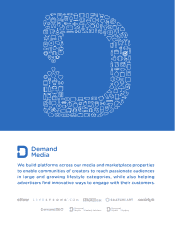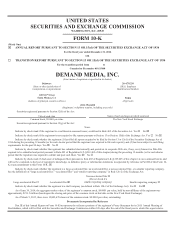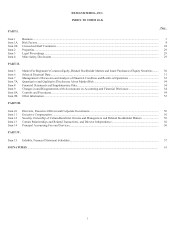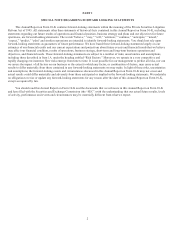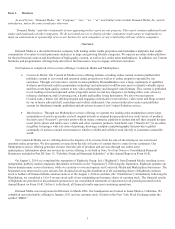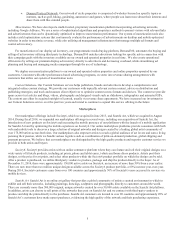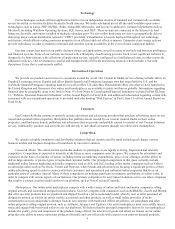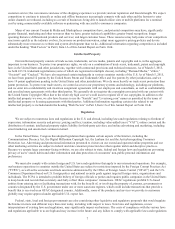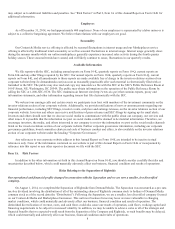Enom 2014 Annual Report Download - page 10
Download and view the complete annual report
Please find page 10 of the 2014 Enom annual report below. You can navigate through the pages in the report by either clicking on the pages listed below, or by using the keyword search tool below to find specific information within the annual report.7
customer service; the convenience and ease of the shopping experience we provide; and our reputation and brand strength. We expect
competition to continue to intensify as online and offline businesses increasingly compete with each other and the barriers to enter
online channels are reduced, including as a result of businesses being able to launch online sites or mobile platforms for a nominal
cost by using commercially-available software or partnering with successful e-commerce companies.
Many of our current Content & Media and Marketplaces competitors have, and potential competitors may have, significantly
greater financial, marketing and other resources than we have; greater technical capabilities; greater brand recognition; longer
operating histories; differentiated products and services; and larger customer bases. These resources may help some of our competitors
react more quickly as the industry evolves, focus more on product innovation, adopt more aggressive pricing policies and devote
substantially more resources to website and system development than we do. Additional information regarding competition is included
under the heading “Risk Factors” in Part I, Item 1A of this Annual Report on Form 10-K.
Intellectual Property
Our intellectual property consists of trade secrets, trademarks, service marks, patents and copyrights and is, in the aggregate,
important to our business. To protect our proprietary rights, we rely on a combination of trade secret, trademark, patent and copyright
laws in the United States and other jurisdictions, together with contractual provisions and technical measures. As of March 5, 2015,
we held 41 U.S. trademark registrations (some of which are registered in multiple classes), including “Demand Media,” “eHow,”
“Society6” and “Cracked.” We have also registered certain trademarks in various countries outside of the U.S. As of March 5, 2015,
we have been granted 12 patents by the United States Patent and Trademark Office and five patents by other jurisdictions, and we
have 19 patent applications pending in the United States and other jurisdictions. We rely more heavily on trade secret protection than
patent protection. To protect our trade secrets, we control access to our proprietary systems and technology, including our platforms,
and we enter into confidentiality and invention assignment agreements with our employees and consultants, as well as confidentiality
and non-disclosure agreements with other third parties. We generally do not register the copyrights associated with our content with
the United States Copyright Office due to the relatively high cost we would incur to register all of our copyrights. In addition to the
intellectual property we own, we also have licenses to use the “Saatchi” and “Livestrong.com” names as permitted by the terms of
intellectual property or licensing agreements with third parties. Additional information regarding certain risks related to our
intellectual property is included under the heading “Risk Factors” in Part I, Item 1A of this Annual Report on Form 10-K.
Regulation
We are subject to numerous laws and regulations in the U.S. and abroad, including laws and regulations relating to freedom of
expression; information security and privacy; pricing and fees; taxation, including value-added taxes (“VAT”); online content and the
distribution of content; intellectual property rights; liability for third-party activities; and online advertising and marketing, including
email marketing and unsolicited commercial email.
In the United States, Congress has adopted legislation that regulates certain aspects of the Internet, including the
Communications Decency Act, the Digital Millenium Copyright Act, the Lanham Act and the Anticybersquatting Consumer
Protection Act. Advertising and promotional information presented to visitors on our owned and operated online properties and our
other marketing activities are subject to federal and state consumer protection laws that regulate unfair and deceptive practices.
Because we operate large consumer-facing websites, we are also subject to state, federal and foreign laws and regulations governing
privacy of users’ search habits and other information and data protection of consumers’ non-public personal information and
preferences.
We must also comply with certain foreign and U.S. laws and regulations that apply to our international operations. For example,
our business operations in countries outside the United States are subject to restrictions imposed by the Foreign Corrupt Practices Act
(“FCPA”), as well as the economic and trade sanctions administered by the Office of Foreign Assets Control (“OFAC”) and the U.S.
Commerce Department based on U.S. foreign policy and national security goals against targeted foreign states, organizations and
individuals. The FCPA is intended to prohibit bribery of foreign officials or parties and requires public companies in the United States
to keep books and records that accurately and fairly reflect those companies’ transactions. OFAC regulations prohibit U.S.-based
entities from entering into or facilitating transactions with, for the benefit of, or involving the property of, persons, governments or
countries designated by the U.S. government under one or more sanctions regimes, which could include transactions that provide a
benefit that is received in an OFAC designated country. Additionally, some of the products and services we provide to customers
globally may require approval under applicable U.S. export law.
Federal, state, local and foreign governments are also considering other legislative and regulatory proposals that would regulate
the Internet in more and different ways than exist today, including with respect to taxes. New laws and regulations, or new
interpretations of existing laws and regulations, may significantly impact our business. The costs of compliance with the various laws
and regulations applicable to us are high and may increase in the future and any failure to comply with applicable laws and regulations


